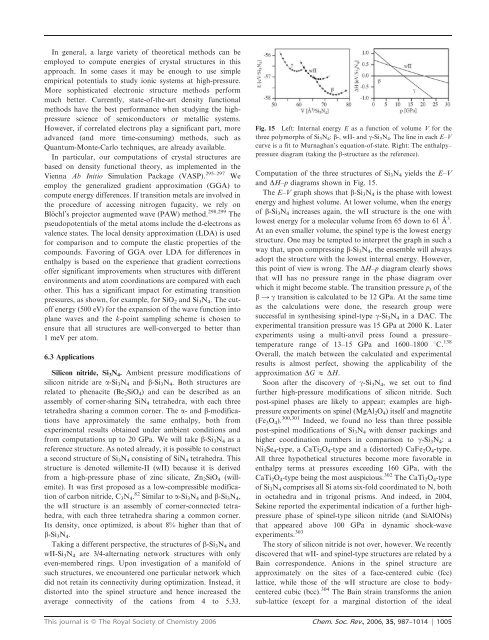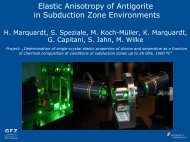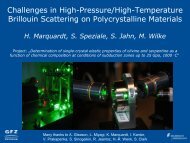High-pressure chemistry of nitride-based materials
High-pressure chemistry of nitride-based materials
High-pressure chemistry of nitride-based materials
Create successful ePaper yourself
Turn your PDF publications into a flip-book with our unique Google optimized e-Paper software.
In general, a large variety <strong>of</strong> theoretical methods can be<br />
employed to compute energies <strong>of</strong> crystal structures in this<br />
approach. In some cases it may be enough to use simple<br />
empirical potentials to study ionic systems at high-<strong>pressure</strong>.<br />
More sophisticated electronic structure methods perform<br />
much better. Currently, state-<strong>of</strong>-the-art density functional<br />
methods have the best performance when studying the high<strong>pressure</strong><br />
science <strong>of</strong> semiconductors or metallic systems.<br />
However, if correlated electrons play a significant part, more<br />
advanced (and more time-consuming) methods, such as<br />
Quantum-Monte-Carlo techniques, are already available.<br />
In particular, our computations <strong>of</strong> crystal structures are<br />
<strong>based</strong> on density functional theory, as implemented in the<br />
Vienna Ab Initio Simulation Package (VASP). 295–297 We<br />
employ the generalized gradient approximation (GGA) to<br />
compute energy differences. If transition metals are involved in<br />
the procedure <strong>of</strong> accessing nitrogen fugacity, we rely on<br />
Blöchl’s projector augmented wave (PAW) method. 298,299 The<br />
pseudopotentials <strong>of</strong> the metal atoms include the d-electrons as<br />
valence states. The local density approximation (LDA) is used<br />
for comparison and to compute the elastic properties <strong>of</strong> the<br />
compounds. Favoring <strong>of</strong> GGA over LDA for differences in<br />
enthalpy is <strong>based</strong> on the experience that gradient corrections<br />
<strong>of</strong>fer significant improvements when structures with different<br />
environments and atom coordinations are compared with each<br />
other. This has a significant impact for estimating transition<br />
<strong>pressure</strong>s, as shown, for example, for SiO 2 and Si 3 N 4 . The cut<strong>of</strong>f<br />
energy (500 eV) for the expansion <strong>of</strong> the wave function into<br />
plane waves and the k-point sampling scheme is chosen to<br />
ensure that all structures are well-converged to better than<br />
1 meV per atom.<br />
6.3 Applications<br />
Silicon <strong>nitride</strong>, Si 3 N 4 . Ambient <strong>pressure</strong> modifications <strong>of</strong><br />
silicon <strong>nitride</strong> are a-Si 3 N 4 and b-Si 3 N 4 . Both structures are<br />
related to phenacite (Be 2 SiO 4 ) and can be described as an<br />
assembly <strong>of</strong> corner-sharing SiN 4 tetrahedra, with each three<br />
tetrahedra sharing a common corner. The a- and b-modifications<br />
have approximately the same enthalpy, both from<br />
experimental results obtained under ambient conditions and<br />
from computations up to 20 GPa. We will take b-Si 3 N 4 as a<br />
reference structure. As noted already, it is possible to construct<br />
a second structure <strong>of</strong> Si 3 N 4 consisting <strong>of</strong> SiN 4 tetrahedra. This<br />
structure is denoted willemite-II (wII) because it is derived<br />
from a high-<strong>pressure</strong> phase <strong>of</strong> zinc silicate, Zn 2 SiO 4 (willemite).<br />
It was first proposed as a low-compressible modification<br />
<strong>of</strong> carbon <strong>nitride</strong>, C 3 N 4 . 82 Similar to a-Si 3 N 4 and b-Si 3 N 4 ,<br />
the wII structure is an assembly <strong>of</strong> corner-connected tetrahedra,<br />
with each three tetrahedra sharing a common corner.<br />
Its density, once optimized, is about 8% higher than that <strong>of</strong><br />
b-Si 3 N 4 .<br />
Taking a different perspective, the structures <strong>of</strong> b-Si 3 N 4 and<br />
wII-Si 3 N 4 are 3/4-alternating network structures with only<br />
even-membered rings. Upon investigation <strong>of</strong> a manifold <strong>of</strong><br />
such structures, we encountered one particular network which<br />
did not retain its connectivity during optimization. Instead, it<br />
distorted into the spinel structure and hence increased the<br />
average connectivity <strong>of</strong> the cations from 4 to 5.33.<br />
Fig. 15 Left: Internal energy E as a function <strong>of</strong> volume V for the<br />
three polymorphs <strong>of</strong> Si 3 N 4 : b-, wII- and c-Si 3 N 4 . The line in each E–V<br />
curve is a fit to Murnaghan’s equation-<strong>of</strong>-state. Right: The enthalpy–<br />
<strong>pressure</strong> diagram (taking the b-structure as the reference).<br />
Computation <strong>of</strong> the three structures <strong>of</strong> Si 3 N 4 yields the E–V<br />
and DH–p diagrams shown in Fig. 15.<br />
The E–V graph shows that b-Si 3 N 4 is the phase with lowest<br />
energy and highest volume. At lower volume, when the energy<br />
<strong>of</strong> b-Si 3 N 4 increases again, the wII structure is the one with<br />
lowest energy for a molecular volume from 65 down to 61 s 3 .<br />
At an even smaller volume, the spinel type is the lowest energy<br />
structure. One may be tempted to interpret the graph in such a<br />
way that, upon compressing b-Si 3 N 4 , the ensemble will always<br />
adopt the structure with the lowest internal energy. However,<br />
this point <strong>of</strong> view is wrong. The DH–p diagram clearly shows<br />
that wII has no <strong>pressure</strong> range in the phase diagram over<br />
which it might become stable. The transition <strong>pressure</strong> p t <strong>of</strong> the<br />
b A c transition is calculated to be 12 GPa. At the same time<br />
as the calculations were done, the research group were<br />
successful in synthesising spinel-type c-Si 3 N 4 in a DAC. The<br />
experimental transition <strong>pressure</strong> was 15 GPa at 2000 K. Later<br />
experiments using a multi-anvil press found a <strong>pressure</strong>–<br />
temperature range <strong>of</strong> 13–15 GPa and 1600–1800 uC. 138<br />
Overall, the match between the calculated and experimental<br />
results is almost perfect, showing the applicability <strong>of</strong> the<br />
approximation DG # DH.<br />
Soon after the discovery <strong>of</strong> c-Si 3 N 4 , we set out to find<br />
further high-<strong>pressure</strong> modifications <strong>of</strong> silicon <strong>nitride</strong>. Such<br />
post-spinel phases are likely to appear; examples are high<strong>pressure</strong><br />
experiments on spinel (MgAl 2 O 4 ) itself and magnetite<br />
(Fe 3 O 4 ). 300,301 Indeed, we found no less than three possible<br />
post-spinel modifications <strong>of</strong> Si 3 N 4 with denser packings and<br />
higher coordination numbers in comparison to c-Si 3 N 4 : a<br />
Ni 3 Se 4 -type, a CaTi 2 O 4 -type and a (distorted) CaFe 2 O 4 -type.<br />
All three hypothetical structures become more favorable in<br />
enthalpy terms at <strong>pressure</strong>s exceeding 160 GPa, with the<br />
CaTi 2 O 4 -type being the most auspicious. 302 The CaTi 2 O 4 -type<br />
<strong>of</strong> Si 3 N 4 comprises all Si atoms six-fold coordinated to N, both<br />
in octahedra and in trigonal prisms. And indeed, in 2004,<br />
Sekine reported the experimental indication <strong>of</strong> a further high<strong>pressure</strong><br />
phase <strong>of</strong> spinel-type silicon <strong>nitride</strong> (and SiAlONs)<br />
that appeared above 100 GPa in dynamic shock-wave<br />
experiments. 303<br />
The story <strong>of</strong> silicon <strong>nitride</strong> is not over, however. We recently<br />
discovered that wII- and spinel-type structures are related by a<br />
Bain correspondence. Anions in the spinel structure are<br />
approximately on the sites <strong>of</strong> a face-centered cubic (fcc)<br />
lattice, while those <strong>of</strong> the wII structure are close to bodycentered<br />
cubic (bcc). 304 The Bain strain transforms the anion<br />
sub-lattice (except for a marginal distortion <strong>of</strong> the ideal<br />
This journal is ß The Royal Society <strong>of</strong> Chemistry 2006 Chem. Soc. Rev., 2006, 35, 987–1014 | 1005





